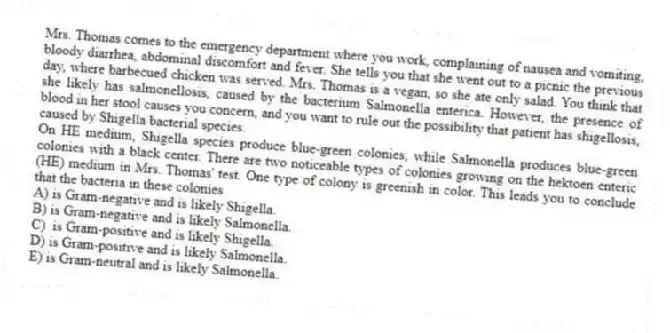
Mrs. Thomas comes to the emergency department where you work, complaining of nausea and vomiting, bloody diarrhea, abdominal discomfort and fever. She tells you that she went out to a picnic the previous day, where barbecued chicken was served. Mrs. Thomas is a vegan, so she ate only salad. You think that she likely has salmonellosis, caused by the bacterium Salmonella enterica. However, the presence of blood in her stool causes you concern, and you want to rule out the possibility that patient has shigellosis, caused by Shigella bacterial species.
-On HE medium, Shigella species produce blue-green colonies, while Salmonella produces blue-green colonies with a black center. There are two noticeable types of colonies growing on the hektoen enteric (HE) medium in Mrs. Thomas' test. One type of colony is greenish in color. This leads you to conclude that the bacteria in these colonies
A) is Gram-negative and is likely Shigella.
B) is Gram-negative and is likely Salmonella.
C) is Gram-positive and is likely Shigella.
D) is Gram-positive and is likely Salmonella.
E) is Gram-neutral and is likely Salmonella.
Correct Answer:
Verified
Q71: You are in charge of water quality
Q72: Shigella species and Salmonella species are classified as
Q73: Eosin methylene blue agar (EMB) is a
Q74: Mrs. Thomas comes to the emergency department
Q75: You are culturing a new bacterium in
Q76: A cluster of cases of legionellosis have
Q77: You take absorbance readings on a spectrophotometer
Q78: A cluster of cases of legionellosis have
Q79: Mr. Jones comes to your clinic complaining
Q81: A cluster of cases of legionellosis have
Unlock this Answer For Free Now!
View this answer and more for free by performing one of the following actions

Scan the QR code to install the App and get 2 free unlocks

Unlock quizzes for free by uploading documents